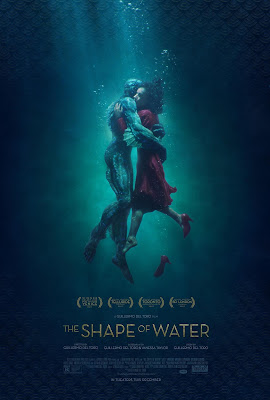The Shape of Water continues Del Toro’s trend of mixing his style with established genres to make something that feels familiar and yet still his own. After taking on Gothic horror with Crimson Peak and post-apocalyptic Godzilla-style monster movies with Pacific Rim, The Shape of Water sees him turn to Douglas Sirk romantic melodramas to color his tale. The production design (from Paul D. Austerberg) is a freaky fun melange of classic 1950s decor and the retro futurism of sci-fi flicks of the day, framed with relish at all sorts of kooky angles by DP Dan Laustsen. The result could best be described as Terry Gilliam making his own circus carnival version of Carol, but with more fish monsters. It’s a hyper-specific and unique sort of film that’s become Del Toro’s calling card over the years. And the look of The Shape of Water is perhaps its best trait, with a depth to its set design that always gives the eye something to latch onto even if it’s the fifth time returning to that place.
The script, written with Vanessa Taylor, makes a conscious effort here to focus on Eliza and her experience, generally leaving much of the mystery on the outskirts of the proceedings. A lesser film might have put all the focus on the fish man: his origins, his abilities, how he’ll be used by the military and so on. Del Toro isn’t concerned with any of that; he focused his exposition almost exclusively within the frame of reference of Eliza. He gives plenty of room to establishing her daily routine, cooking hard boiled eggs and watching classic movies with Giles. The Shape of Water paints such a clear picture of who Eliza is that we have a keen sense of her tender heart, her vulnerability, her kindness and her loneliness. And all of that comes down to Sally Hawkins, forced to create these shades of character and personality without benefit of speech. Her face and her body language are remarkably expressive, and she’s buoyed by actors with the quality of Richard Jenkins and Octavia Spencer playing her confidants. Jenkins is (unsurprisingly) especially strong here, equally lonely and outcast in his own way with an artist’s soul. Michael Shannon can uncork the menace without batting an eye, though it would be nice if there were a little more to his character than simply being a heavy. We get a glimpse of who he is with some quick asides to his home life, but I wanted a little more to sink my teeth into.
That extra bit of spice we get from Jenkins can also be found in Stuhlbarg’s character, harboring a secret that recontextualizes his actions in an enjoyably subtle way. And then of course is Doug Jones, no stranger to Del Toro films, nor is he a stranger to this specific sort of costume. This is his largest role to date, having previously played all sorts of monsters, but when put under the spotlight he proves he’s up to the challenge. His job is even more difficult than Hawkins’, buried under a mountain of makeup and prosthetics as he is, but he generates an astounding range of emotions that makes him an equal part of the central romance.
All told, this is Del Toro’s most complete and satisfying film since Pan's Labyrinth. He’s perfectly at home in the 50’s melodrama trappings, and does some fiendishly clever things with the premise (including a wonderful dream sequence that has to be seen to be believed). Despite the grimy nature of the facility and Strickland’s gleeful sadism, there’s a wholesomeness to this world, a place where people who love and respect each other can get on board with a woman falling in love with a fish because they can tell it’s real love, and real love is too important to let a silly thing like different species get in the way. That sounds flippant, but in practice, it works incredibly well. The performances from Hawkins, Jones, Jenkins and Spencer, the intricate design of every sumptuous moment framed beautifully, all of it adds up to a wonderful ode to classic melodrama through a lens only a unique mind like Guillermo Del Toro could bring to the screen. This is the Del Toro I’ve always wanted, the auteur who can back up his wild ideas and visuals with real content. It’s good to have him back.

No comments:
Post a Comment